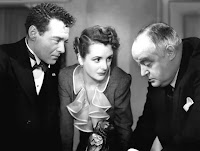Why am I using that famous question as the title?
No reason.
So, a while back, someone I was working with asked if I’d be willing to look over a script he’d been working on with a friend. I said sure, because I hadn’t yet learned to be wary of such situations. And then spent a few days figuring out what I could politely say about said script…
Almost two-thirds of the script was other movies. Quotes from other movies. Visual references to other movies. Deliberate parallel scenes from other movies. Discussions about other movies. And what was left–the original material– wasn’t much.
Let me tell you another little story.
I was reading a script for one contest where the main character was named Sam Spade. He worked in a diner where their specialty chicken sandwich was called the Black Bird.  One of his regulars was named Archer. There’s a waitress named Brigid, and the cook was named Wilmer. Then one day a guy named Cairo wanders in. He works for a fellow named Gutman.
One of his regulars was named Archer. There’s a waitress named Brigid, and the cook was named Wilmer. Then one day a guy named Cairo wanders in. He works for a fellow named Gutman.
These are the names of pretty much every character in The Maltese Falcon, by the way. If you didn’t know that, hang your head in shame and go rearrange your Netflix queue. How are you going to write anything new if you don’t know the classics?
Anyway, I’m getting away from the point.
What was the point, you ask?
Well, that’s a good question. What was the point of all these names and moments and interactions? If someone’s characters are going to do nothing but talk about movies and they’ve written their script to shamelessly copy movies, what do you think it’s about?
That’s right. It’s about a lost dog.
And that other one. With all those Maltese Falcon references, there’s got to be a lost treasure or a mystery or something going on, right?
Nope. It was a slice-of-life story about this person’s dreams and that person’s aspirations and desperate sex in the storeroom and driving home at night with the music loud. That’s it.
Soooooo… what’s up with all those references?
Personally, I blame Kevin Smith.
Ever since those guys in Clerks had a long debate about the contractors who built the Death Star, dropping references into stories and dialogue has become a standard. Oh, people did it before him but he started doing it in movies and made it very widespread. Smith still does it. Stephen King does it. I do it.
(…like how I lump myself in with the big guys? Not egotistical at all…)
The catch, of course, is that these writers have a reason for doing this. When Dante and Randall get in an argument about the Star Wars trilogy, we’re learning more about them than we are about the movies. When Milla Jovovich’s confused character in Resident Evil goes down into an unbelievable underground world, is it that shocking to discover she’s named Alice?
And let’s not forget that sometimes the reference is just there to drive home similarities or contrasts. In my own books, the Mighty Dragon’s real name is George Bailey. Remember the poor sap in Office Space who’s named Michael Bolton but loathes that musician’s songs?
Y’see, Timmy, once you start throwing out lots of familiar names and sequences, people are going to start looking for patterns. That’s what a good audience does. And there needs to be one. Each of these odd names or references is going to knock a reader out of the story for a moment or two, and if you don’t have any sort of payoff for that disruption… well, it’s not going to go over well.
Not only that, if you don’t acknowledge the oddness of everyone who enters this diner having the same name as a Maltese Falcon character, your readers are just going to get annoyed. If you acknowledge it but don’t have a real, in-story reason why all of them have these names, that’s going to be seriously annoying.
No, sorry, it’s not acceptable just because your three best friends said it was really cool and it wasn’t disruptive.
If you’re going to do something clever in your story, awesome. As long as there’s a real reason for doing it.
Speaking of doing it… next week’s going to be pretty close to Valentine’s Day. I thought I’d ramble on about the rules of love. Yep, there are rules. If only I’d known them in high school. Or college.
Until then, go write.

